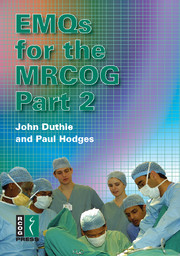Book contents
- Frontmatter
- Contents
- Preface
- Acknowledgements
- Abbreviations
- Foreword
- How to use this book
- 1 The educational and evaluative benefits of EMQs
- 2 EMQ answering technique
- 3 Worked examples
- 4 Mock examination 1
- 5 Mock examination 2
- 6 Mock examination 1 answers
- 7 Mock examination 2 answers
- Appendix 1 Mock examinations answer keys
- Appendix 2 Mock examinations answer sheet (blank)
- Index
2 - EMQ answering technique
Published online by Cambridge University Press: 05 July 2014
- Frontmatter
- Contents
- Preface
- Acknowledgements
- Abbreviations
- Foreword
- How to use this book
- 1 The educational and evaluative benefits of EMQs
- 2 EMQ answering technique
- 3 Worked examples
- 4 Mock examination 1
- 5 Mock examination 2
- 6 Mock examination 1 answers
- 7 Mock examination 2 answers
- Appendix 1 Mock examinations answer keys
- Appendix 2 Mock examinations answer sheet (blank)
- Index
Summary
Introduction
A candidate with a sound knowledge of obstetrics and gynaecology who has received the appropriate supervised training and gained adequate clinical experience should have little difficulty in tackling EMQs. However, failure to appreciate the relationship between knowledge and technique may affect your performance in the examination. Essentially, both your knowledge and technique should be sound.
The overall purpose of the EMQ is to probe a candidate's understanding of clinical obstetrics and gynaecology. They tend to assess the application of medical knowledge rather than simple recall, by giving a number of possible answers to a short clinical problem. They are replacing a number of the true/false multiple-choice questions (MCQs) and slightly reducing the need to write short answer questions (essays), which would be marked by subject matter experts.
Attributes of EMQs
So what are the main differences between EMQs and these more familiar types of formats for assessment?
With the wider number of options available, it is obvious that the educated guess becomes a far less valuable technique than in the 50 : 50 world of the true or false MCQ. Studies demonstrate that even in negatively marked MCQ papers all candidates should benefit substantially from backing their educated guesses and only a small percentage lose marks by backing their wild guesses. The RCOG MCQ and EMQ papers are not negatively marked, making the technique potentially even more potent.
Information
- Type
- Chapter
- Information
- EMQs for the MRCOG Part 2 , pp. 3 - 10Publisher: Cambridge University PressPrint publication year: 2006
